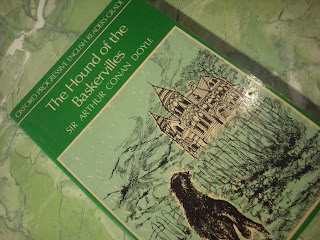
Last night I went to Gramedia bookstore with my bfriend and we saw this Edgar Allan Poe book (sorry, I didn't see the title). I said to him, "Edgar Allan Poe was the father of Detectives stories. He made the basics of detective plots which writers nowadays use". Well, I didn't say it precisely like that but more or less like that. But since I forgot what exactly was was the five principles of detectives stories, I told him that I'd send it later on. Coincidentally I used Poe's profile as a work for my Major American Writers final paper (at that time I was on my 6th Semester... ages ago!)
My lecturer asked what influences and significance does the writer's works bring to the contemporary and following writers? Since I chose Poe, I had to dig out some information. It turned out that his stories are used as the detective principles and still used nowadays. To be honest, I haven't read any of his works, but the detective principles being used in them, I've read them in other detective stories by various detective writers.
Here are the five detective principles by Edgar Allan Poe that is still used until now:
a. The Murders in the Rue Morgue (1841)
It introduces the plot of ‘locked-room cases’. This is where the murder seemed to be done in impossible location. Usually it is depicted by murder happening inside a room which is locked from inside to make it seem like a suicide. Famous Japanese comic writer, Aoyama Gosho, often use the ‘locked-room cases’ in his manga entitled Detective Conan (1994-...) to show the mystery and cleverness of how a murder can be done in impossible places. For example, in file 4, volume 25, "House of the Spiders" the victim was hung in a locked room. There was this little window but it was too little and too high from someone to escape from it.
b. The Gold Bug (1843)
This story contained solution which relies on coded message. Many detective stories nowadays, either written or visualized, uses this coded message to solve the problem. Dan Brown, author of the famous novel The Da Vinci Code (2006), used coded messages in the form of Leonardo Da Vinci’s work to solve the mystery. Alfred Hitchcock used this also in his book "Three Investigators: The Mystery of the Stuttering Parrot". Great book with quote from Sherlock Holmes, To-to-to-be or not to-to-to-be. That is the question. I really love coded messages!
c. The Mystery of Marie Rogét (1842-1843)
This story is an essay in armchair detection. This is where a detective solves the mystery by various logical deductions from evidence that are presented to him. This method is a common method being used in the detective story. I don't read many stories like this, except maybe Agatha Christie's "Miss Marple".
d. Thou Art the Man (1844)
This story’s detective principle is revealing the most unlikely person as the murder. It is also the first comic detective story. Personally I think that this is the most common principle being used in detective stories. Aoyama Gosho often uses this as the villain of his comic, Detective Conan. Agatha Christie also uses this theory in most of her story, for instance in her story The Secret Adversary (1922), the main villain is the person who is a very famous politician and also trusted by the country. Based on this principle, I never suspect no one, I always suspect everyone!
e. The Purloined Letter (1845)
This presents the theory that when all other possibilities have been discarded, the one remaining, however apparently improbable, must be correct. Sir Arthur Conan Doyle (1859-1930), stated this in his story The Sign of Four (1890) where Holmes said, ‘It is an old maxim of mine that when you have excluded the impossible, whatever remains, however improbable, must be the truth’ (Microsoft ® Encarta ® 2006. © 1993-2005 Microsoft Corporation. All rights reserved.). Sinichi Kudo, Aoyama Gosho's character in "Detective Conan", also uses this theory in his detective comic.
I used to read a lot of Agatha Christie, Sir Arthur Conan Doyle, Aoyama Gosho, and other detective and mystery stories but I never really realized that the principles were taken from Poe's works. Maybe this is because detective stories are identical with Sherlock Holmes and the likes! Well, maybe if I have time later I'll try to read his stories. Starting, maybe, from "The Gold Bug". Who knows that I have a mind of a detective. Hehe.

Aoyama Gosho's "Detective Conan", Indonesian version. Sorry, volume 25 looks messy.

Sir Arthur Conan Doyle's "Sherlock Holmes: The Hound of the Baskervilles"

Agatha Christie's "Tommy and Tuppence" series. They are sooo amusing.

the third principle is sometimes used by Aoyama Gosho. Firstly, Conan usually makes a logically ordered evidence to reveal the true murderer from several (usually 3) persons suspected,,then he exposes the tricks.. :)
ReplyDeleteThen it means Aoyama Gosho uses all five principals! I really need to read at least one of his stories. But somehow I think it's too "dark" for my taste.
ReplyDelete